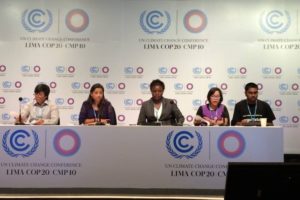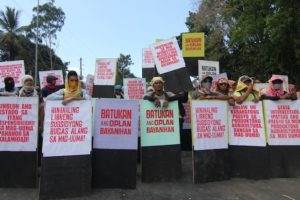[[{“type”:”media”,”view_mode”:”media_large”,”fid”:”44″,”attributes”:{“alt”:””,”class”:”media-image”,”height”:”178″,”style”:”width: 310px; height: 178px; margin: 10px; float: right;”,”typeof”:”foaf:Image”,”width”:”310″}}]]
IBON International Statement on the Doha outcomes
Manila, Philippines, December 10, 2012
The recently concluded climate negotiations in Doha, Qatar, are being spun as having opened “a gateway to greater ambition and action on climate change”. In reality they merely kept the Kyoto Protocol alive, just enough to be able to claim a multilateral framework for dealing with the climate crisis still exists. But this is a much-weakened multilateral framework that is full of loopholes and clearly inadequate to the task of preventing irreversible climate change. Crucially, it has failed to provide the immediate action needed to address climate change now. Instead, all the tough decisions that needed to be made to “raise ambition and action on climate change” have essentially been postponed to 2015 or beyond—for implementation in 2020 onwards. In other words, the world has been locked into another decade of official inaction in the face of a planetary emergency.
The only significant outcome of Doha is the official recognition of the loss and damage suffered by developing countries as a result of climate change, possibly paving the way for “aid” and loans from developed countries in response. But developed countries led by the US ensured that any pledges will not be construed as compensation or legal liability for historical damage to the atmosphere wrought by the advanced industrialized countries for a century-and-a-half of pollution.
It also opened up a new work program on new market mechanisms to extend and expand the so-called flexibility mechanisms. This allows the developed countries to buy their way out of making good on their emissions reductions targets through carbon markets and offsets while giving bankers and traders new opportunities to make profits from new financial instruments.
When the dust settles on Doha in the wake of COP 18, it may be well remembered as having paved the way towards the craven acceptance that it would be more “pragmatic” to deal with the consequences of the climate crisis rather than address its root causes.
A failed COP
Whether on reducing emissions, financing mitigation and adaptation, transferring technology or dealing with the mounting losses and damages wrought by climate change, the leaders of the countries most responsible for the climate crisis refused to make any meaningful commitments in Doha.
- The second commitment period of the Kyoto Protocol, the only legally binding multilateral emissions treaty, has been extended to eight years, locking in until 2020 unambitious treaty which Japan, Russia and Canada have pulled out from, joining the US, which never ratified it. It contains a call for Kyoto Protocol countries to review their emissions reduction target in line with the 25-40% range by 2014 at the latest.
- The treaty includes loopholes such as the carry-over of surplus allowances in reductions from the first commitment period and the trading of unused carbon emissions permits, known as “hot air”.
- On finance, developed countries have failed to produce the immediate funding needed and required in line with their historic responsibility for causing climate change. Firm decisions have been put back to 2013, with no commitments on how the pledged US$100 billion a year will be provided by 2020 and no guarantees of the US$60 billion a year developing countries demanded with immediate effect.
- There has been an agreement on “loss and damage from climate change”; this was hard fought by developing countries. However, there is a lack of clarity as to where funds will come from and how they will be disbursed. The US opposed any language invoking legal liability.
- COP 19 in Warsaw, Poland, will confront many issues from the “Doha Climate Gateway”, including the details of funding on loss and damage. Talks will center on a new treaty to be formalized in 2015 and begin in 2020.
Not enough
These outcomes are far from what climate science requires and what social justice demands.
The agreement reached in Doha fails to do enough to save the lives of the millions in the Global South who bear the brunt of a history of pollution by the world’s industrialized countries.
As the Seychelles negotiator Ronald Jumeau said to the US negotiator: "If we had had more ambition [on emissions cuts from rich countries], we would not have to ask for so much [money] for adaptation. If there had been more money for adaptation [to climate change], we would not be looking for money for loss and damage. What's next? Loss of our islands?"
Developed countries have merely pledged to a set of meager reductions on their GHG emissions compared to 1990 levels. Australia agreed to a paltry 0.5 percent cut on its 1990 emissions levels by 2020, with further cuts dependent on wider international action. The EU agreed to a target of a 20 percent reduction, saying 30 percent would require other developed countries' commitment to comparable emission reductions. Many EU countries have almost reached this target already.
The US said it will cut emissions by 7 percent in 2020 from 2005 levels, which corresponds to a cut of 3 to 4 percent below 1990 levels. However this is not legally binding, as the US is outside of the Kyoto Protocol treaty altogether.
With only some 36 countries left in the second commitment period, the Kyoto Protocol treaty now accounts for only some 15 percent of global emissions. This continues to lock us into a path towards a 4°C temperature rise, which would reduce rice and corn yields by nearly half, raising the specter of mass starvation. Millions will be forced to flee their homes due to rising sea levels or drought. Mass extinction of species would accelerate. In just two or three generations, the world will be much more inhospitable for humanity.
On the crucial matter of financing, most of the deals made were not in the official negotiations but on the sidelines where the climate crisis was being sold as an investment opportunity for big business and big banks.
In the negotiations there were no concrete commitments to public money from developed countries for developing countries to adapt to climate change and pursue sustainable development. This is a far cry from the estimated US$1 trillion for mitigation and hundreds of billions needed annually for adaptation in developing countries, as well as the concrete commitments needed to cover loss and damage every year.
Responsibility for this epic failure falls squarely on the shoulders of the wealthiest countries, which are also the biggest historical polluters. Instead of addressing climate change and bringing about climate justice, developed countries focused on a new treaty for 2020, whereas science shows that the drastic cuts needed to ensure a stop to runaway climate change are needed now.
They used the refusal of emerging economies—particularly China—to make binding commitments as pretext for obstructing a meaningful second commitment period. While some developing countries, particularly those who are among the top historical emitters, should also make commitments to reduce emissions significantly, the G77 was correct to stand united in demanding that the developed countries which have occupied more than their fair share of the atmospheric space must first deliver on their unfulfilled commitments on reductions and finance.
What now?
In the face of worsening impacts of climate change people should continue to push their governments to respect, protect and fulfill the right to life. We should demand remedies for violations of our rights. We should maximize all available avenues for demanding climate justice for our communities and our people at the national and international level, including courts, parliaments and international bodies.
We cannot simply rely on the world’s leaders who have once again demonstrated their utter disregard for the interests of the vast majority of the world’s population today, as well as for future generations. Social movements, civil society and communities in the North and the South must reinvigorate efforts to organize and mobilize people, resist false solutions, resist operations of big business that contribute to climate change, build alternative systems, and set the world on the path to sustainability from the ground up.
The People’s Movement on Climate Change (PMCC) has outlined a five-point plan for action on climate change based on four principles – “The People’s Protocol on Climate Change”. The four principles are social justice (acknowledging systemic roots of the crisis), people’s sovereignty (over resources and institutions), respect for the environment (rejecting market mechanisms), and responsibility (common but differentiated responsibility). These translate into the five action points of:
1) Comprehensive and concerted, but differentiated and equitable emissions cuts to hold temperature rise to 1.5°C;
2) The reparation of Southern countries by Northern countries, TNCs and institutions to redress historical injustices associated with climate change;
3) The rejection of false solutions, such as carbon markets and offsetting, which allow Northern states and corporations to continue harming the environment, provide opportunities for profit and expand corporate control of the environment;
4) Struggling for ecologically sustainable, socially just, pro-people, and long-lasting solutions; and
5) Strengthening the people’s movement on climate change.
All these points tie into the need for true sustainable development to address the roots of the climate crisis and restore harmony between people and nature.



